Bimota Tesi H2 / KB4 Review
Review by Mat Mladin – Images Half Light
It’s awesome to be feeling good and in good enough shape to be able to enjoy riding a motorcycle again. Trev from MCNews.com.au obviously guessed I had a bit of an itch that might need scratching, so threw me the keys to two quite exclusive machines for a few laps around Sydney Motorsports Park recently.
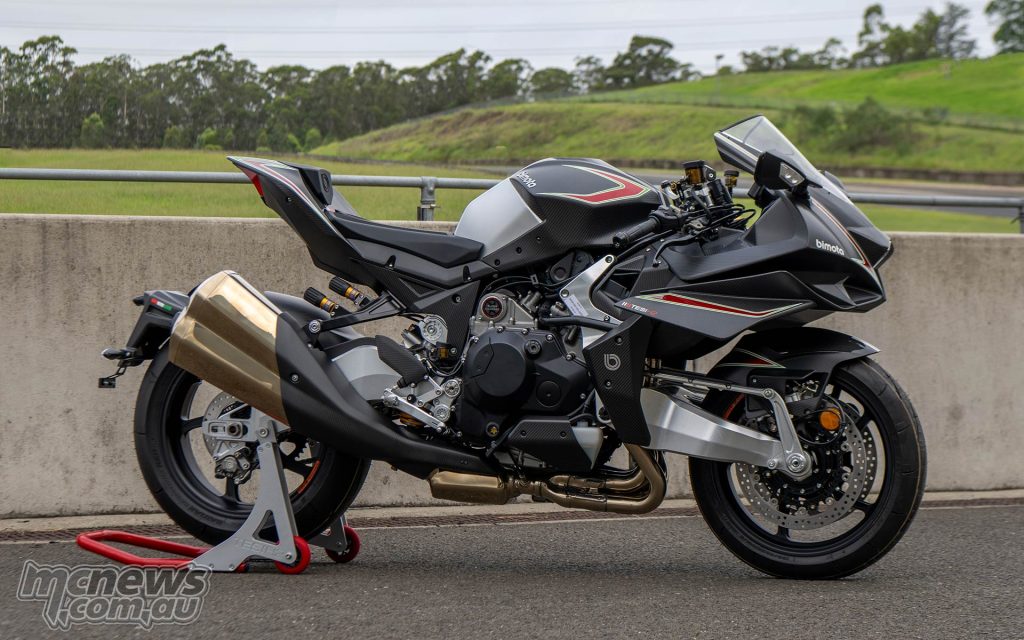
I haven’t really felt the desire to ride a sport bike since I retired from racing 14 years ago. I tried a couple of times, but got absolutely no enjoyment out of it at all. However, when Trev asked me to have a crack on these new Bimota machines at SMSP, I found I was kind of excited.
If you aren’t already aware, Kawasaki Heavy Industries purchased 49.9 per cent of Bimota back in 2019. The Tesi H2 and KB4 are the first collaborations between the two companies in 40 years.
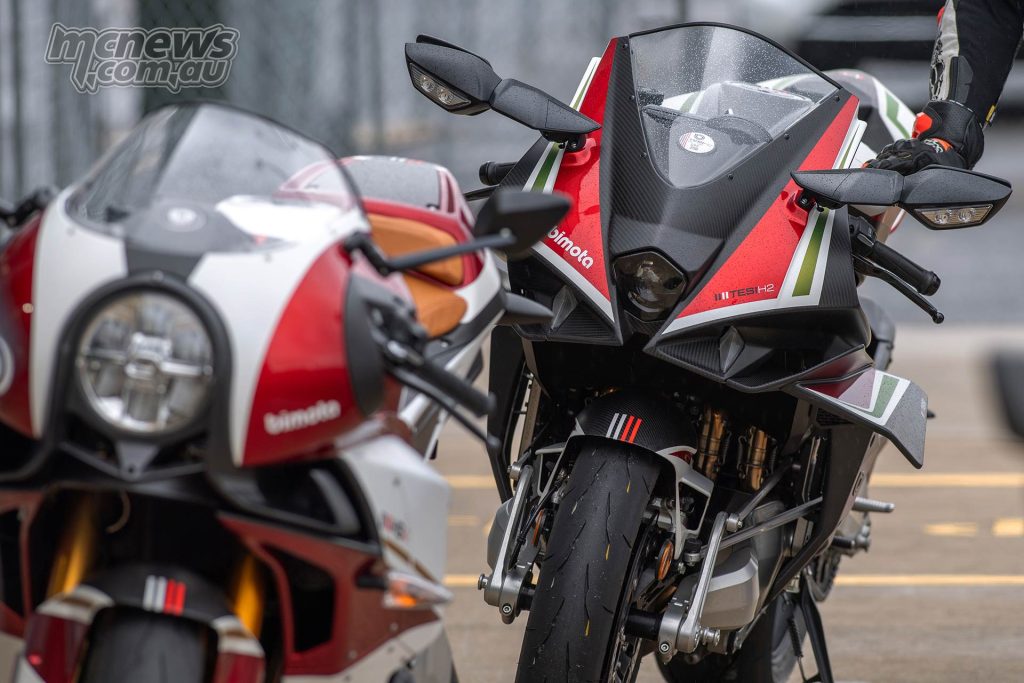
Bimota’s wheelhouse has been to grab an engine and its management system from one of the other manufacturers, and build their own little piece of Italy around it. Both the Tesi H2 and the KB4 are no different and with the buy in, Kawasaki will now be heavily involved in Bimota’s future.
You can find all the specs on both of these Italian beauties below. But specs mean very little to me. How a bike feels means everything, especially for street riding. But generally kit like Brembo and Ohlins speak for themselves.
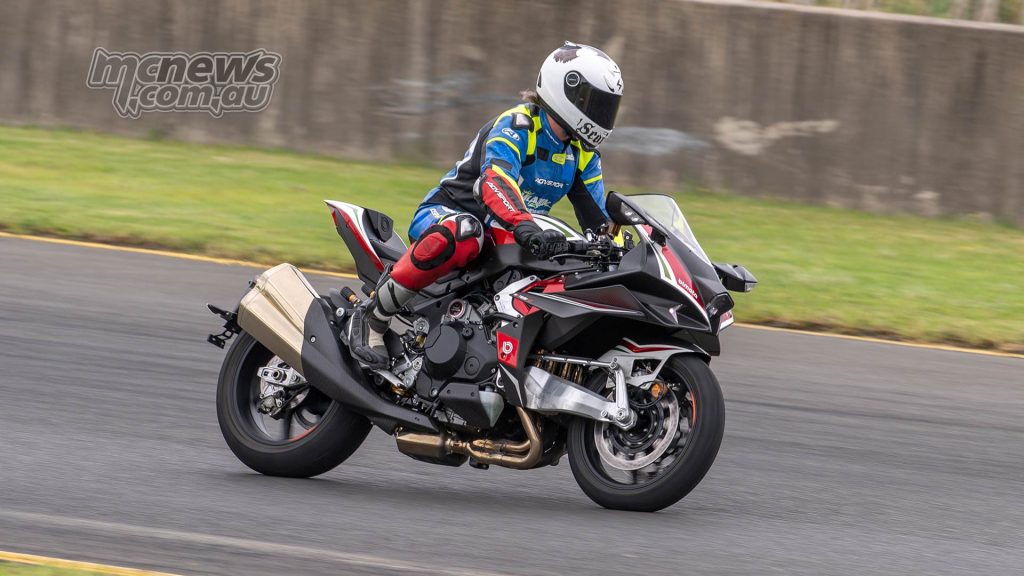
I rode the bikes in two different ways because realistically I can’t see either of these bikes showing up for many track days, so they will probably be exclusively ridden on the road. Mostly I rode sitting in the middle of the seat and not putting too much body input into the bike and handlebars, more like we would on a road ride.
Approaching the bikes in the pit garage for the first time, what came to mind was how different the Tesi H2 and the KB4 looked. With most brands you could tell the manufacturer from 100 paces just by looking at them, not these two bikes. The Tesi H2 seems very Kawasaki inspired, while the KB4 may appeal much more to the Bimota purist.
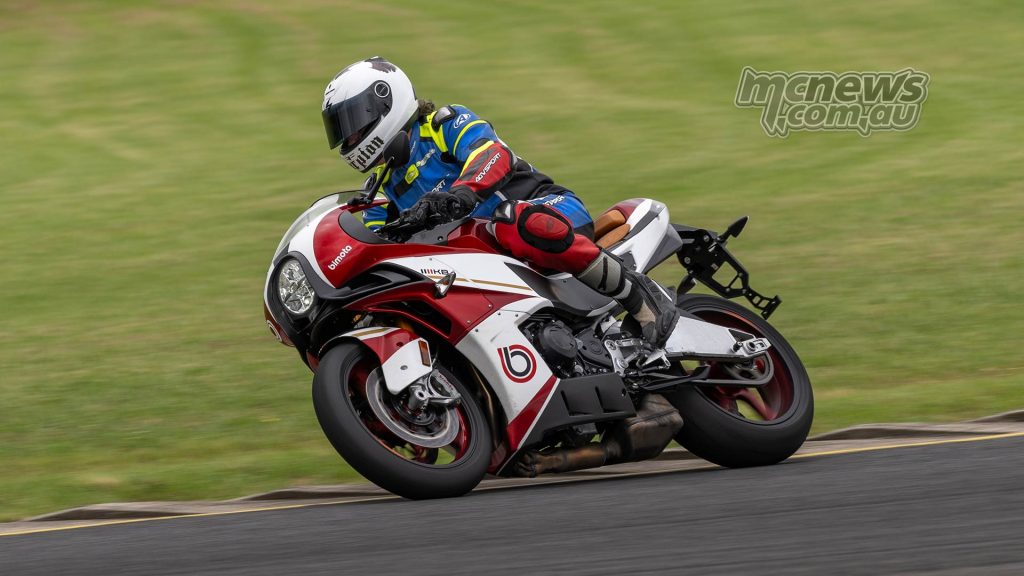
The talk everywhere before I rode the bikes was mostly centred around the Tesi and its supercharged 230 horsepower engine and the swing-arm front end. However, I’ll start with the bike that I enjoyed the most.
If I was purchasing one of these two bikes it would be the KB4. I personally really like the look of it. It has a retro style and grew on me throughout the day.
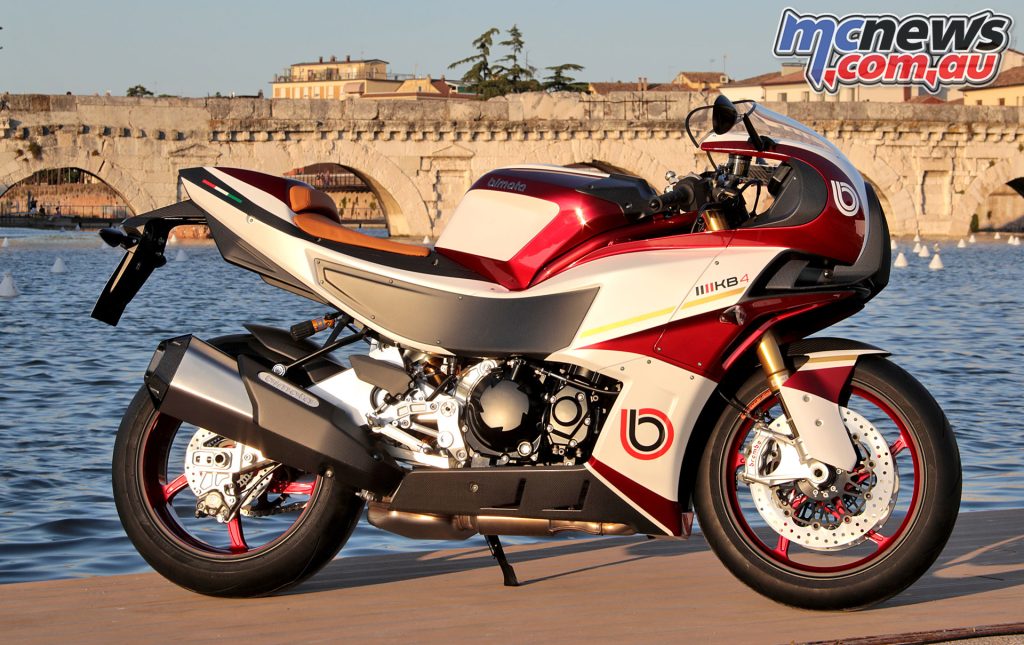
The motor was beautiful and smooth right from initial throttle pick up and from way down low in the rpm and all the way through. If you knew how fastidious (my crew would say a pain in the arse) I was when it came to how I needed a very smooth throttle response on initial pick up of the throttle, then you would better understand when I say how smooth the KB4 actually is.
I left the bike in third gear for the whole lap when doing a few laps road style, and there was sufficient torque from right down low, even for the ridiculously tight hairpin out the back. When pushing it, I was using second gear in the tighter corners, and the KB4 pulled hard.
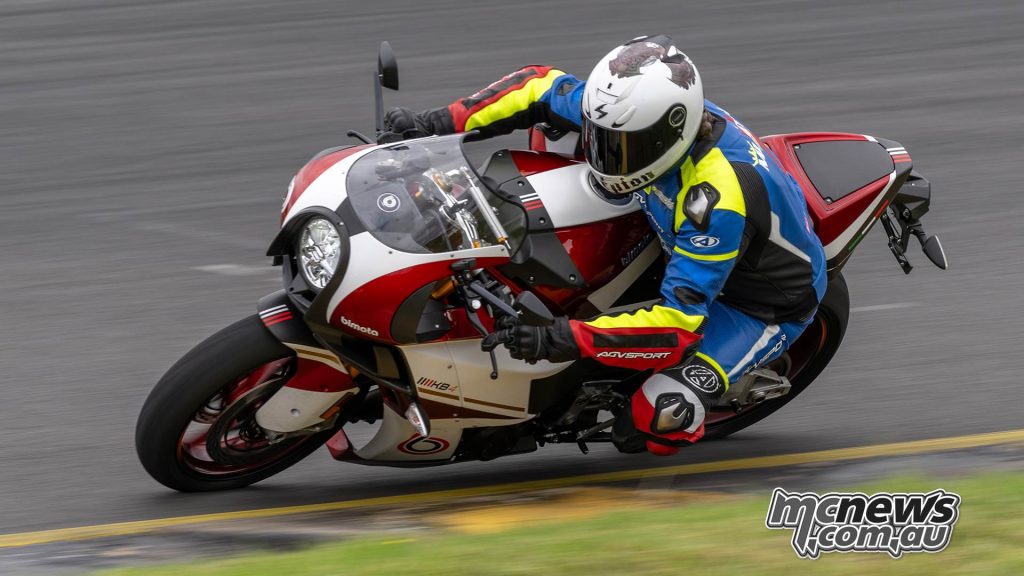
Both ends of the suspension were too soft for me straight out of the box but there was good feedback through the bike. The KB4 felt very light flicking it from side to side. This day was purely to get a feel of the bikes and get some pictures, so little to no adjustments were done.
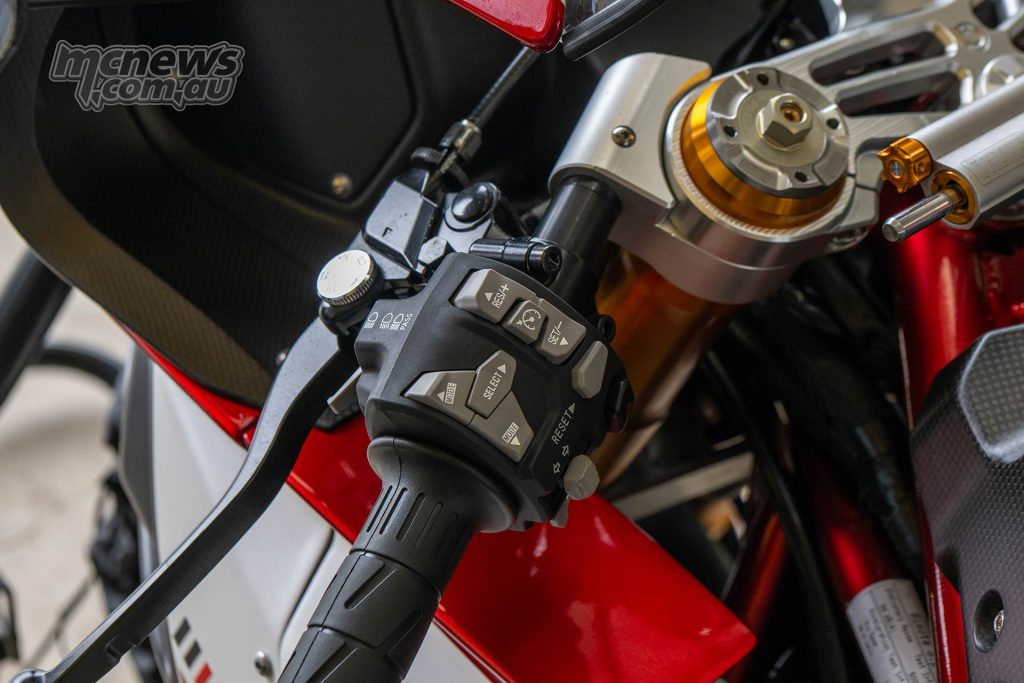
It’s important to remember that I was a racer that used suspension so hard that many of my team-mates thought I was nuts. In 1992, my first year on the Superbike, we ran the WSBK round at Phillip Island and the Ohlins boys from Sweden pushed on my forks and they thought something was wrong with them. Any stock bike is going to feel soft to me. The stock Pirellis stuck like crap to a blanket though and that helped.
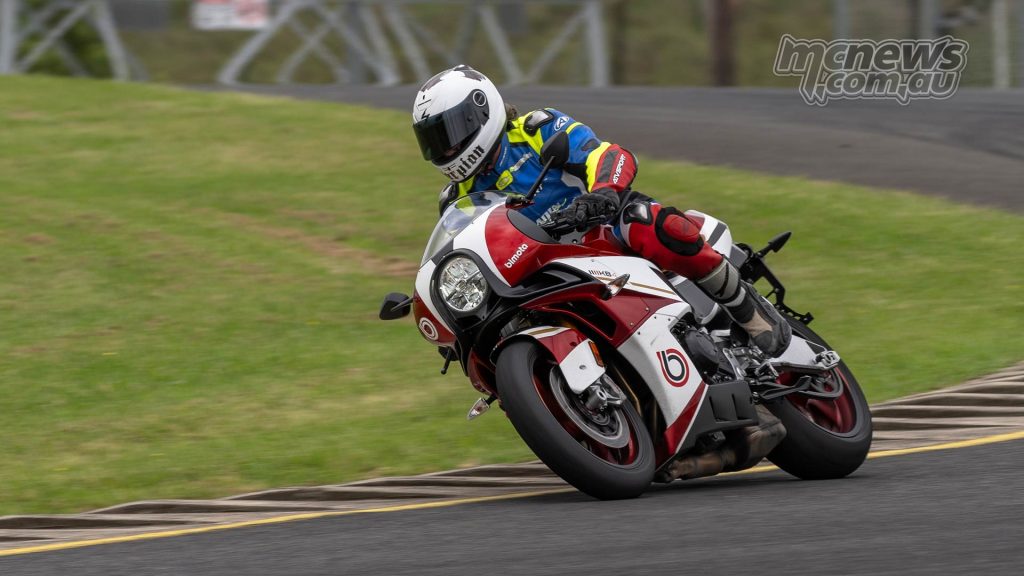
I didn’t touch any of the whiz-bang buttons and adjustments for the traction control or any of that stuff. No point with how slow I ride these days. The quick-shifter worked excellent, every time. The KB4 was fun to ride.
The Tesi H2 was interesting. I really like the styling of the bike and the swing-arm on the front looks pretty cool.
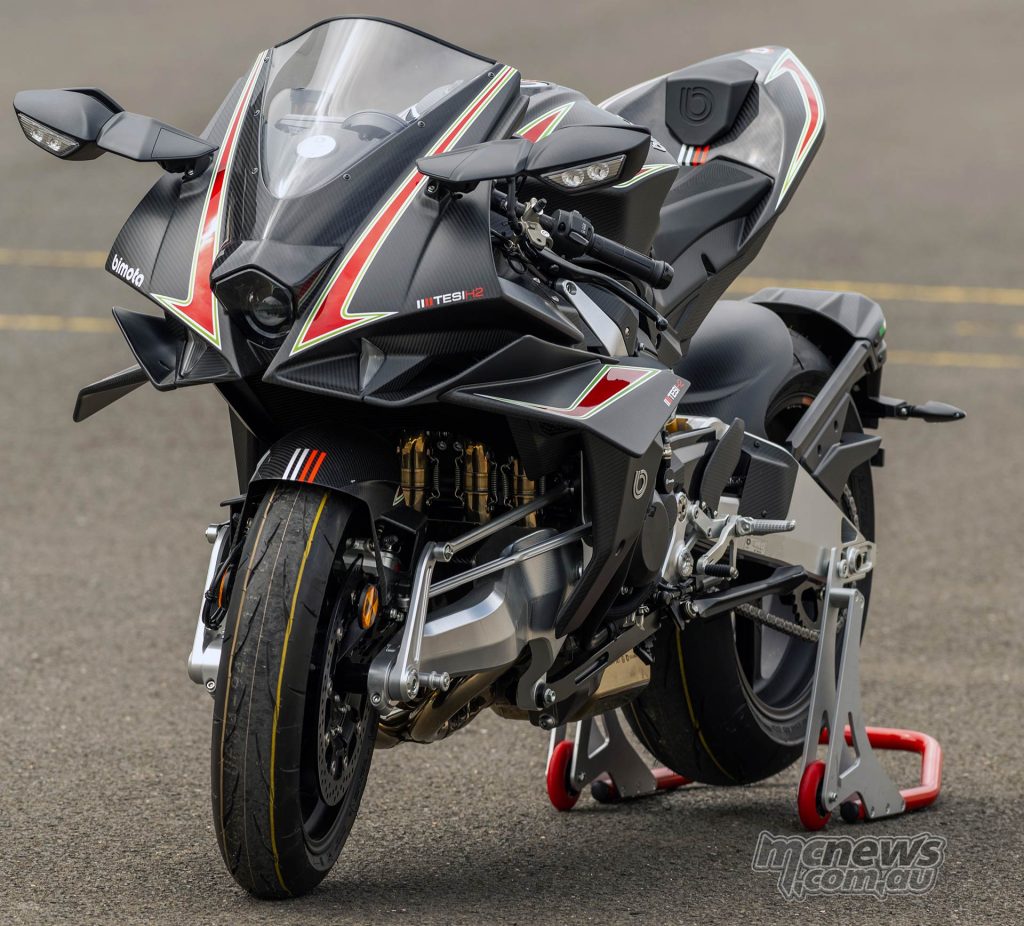
A 230 hp supercharged street bike… The Tesi H2, bar the front swingarm, seems more Kawasaki inspired.

The engine was very powerful; there is absolutely no doubt about that. Other than the very abrupt initial throttle opening where the bike jumped too aggressively, the motor pulled smoothly, and to say it was very strong is a distinct understatement.
The engine and all electronics are Kawasaki, so I wouldn’t expect anything less than everything working well. The quick-shifter was smooth and precise.
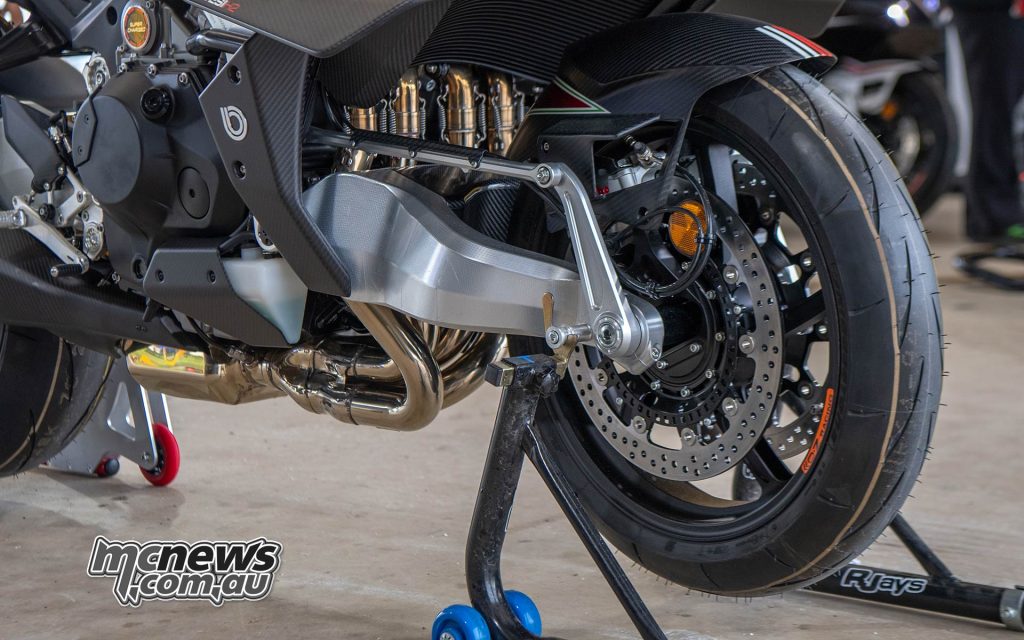
You also get a full arrow exhaust system as part of the package which I’m told saves about eight kilograms. They have designed a nifty little set-up for the headers to be changed quickly. Directly on the exhaust side, they have four short little headers that turn down at ninety degrees and are maybe 100 mm in length.
This is where the whole exhaust is mounted up by the usual exhaust springs. It’s a smart design and will make any owner happy when it comes time to try out the aftermarket Arrow system.

That lever hanging out the front, in my opinion, needs some set-up time to make it work as well as it can, that is if you want to ride the bike harder than a typical road ride. It’s quite a complicated system.
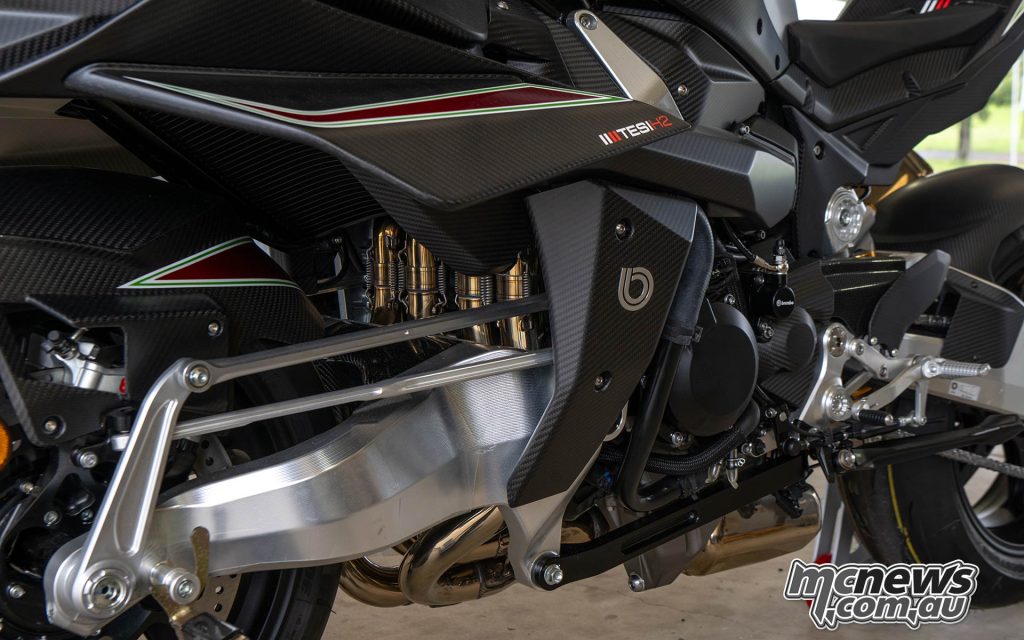
Trying to get as much feel through a rear cushion unit that travels less than half the amount than normal conventional forks travel is a big ask, especially through a linkage system like this. Both front and rear swing-arms are bolted to the engine. There is no ‘typical chassis’.
I had a good look under the bike to see what was going on. The dual RSUs obviously stand out.

The one on the left of the bike controls the front swing-arm. The right side shock controls the rear end. The linkages for front and back are very different. I’d be interested to know what the ratios of both are.
Riding in a more road style the front end of the Tesi felt fine, but when pushing a little I found there to be some vagueness in feedback to the rider.
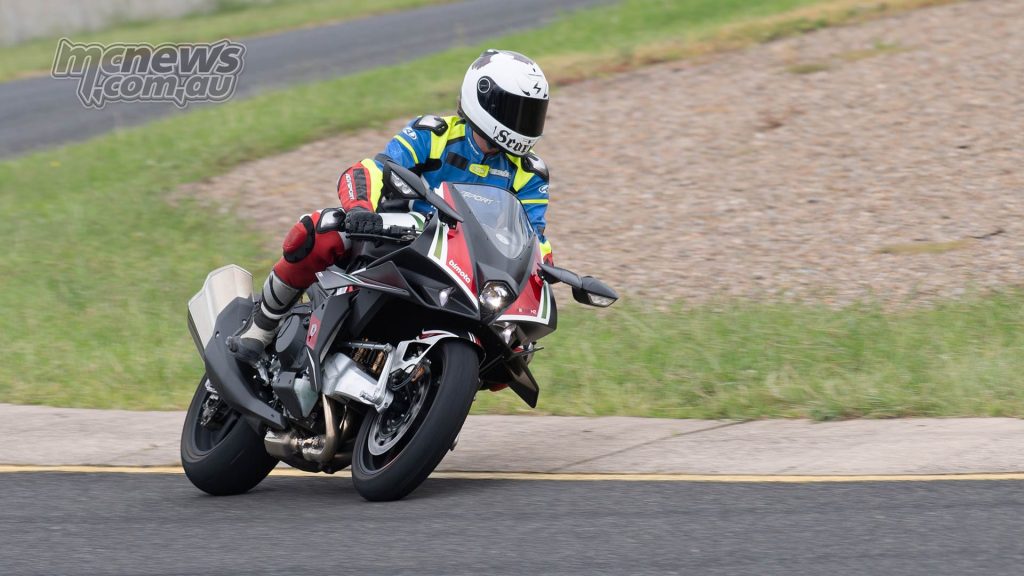
Rear ride height is easily adjusted, as is front and rear spring pre-load, compression and rebound settings. Literally reach down the left or right side of the bike and the adjusters are at your fingertips.

For the lovers of motorcycles with wings, the Tesi doesn’t disappoint. It has the largest wing on the front of a bike that I have ever seen. I’m not one of them lovers of wings. I still prefer a more traditional look, and fortunately Bimota have obviously thought about this, the wings are removable with two simple screws on each side. It’s a one minute job, nice.
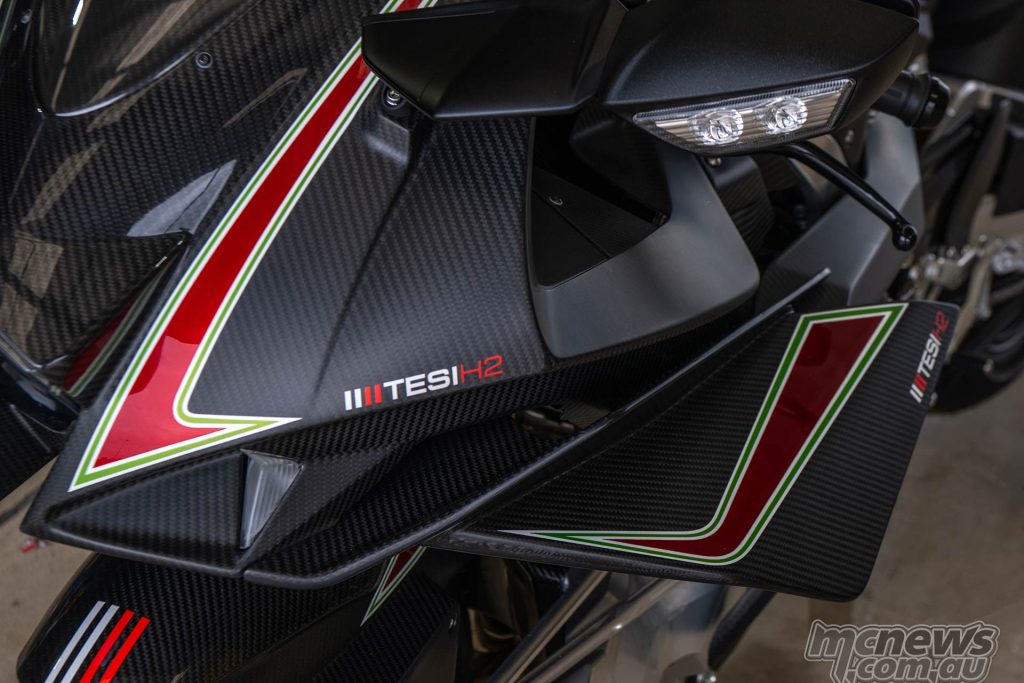
Bimota has delivered two very different motorcycles, they are both gorgeous and offer quite unique riding experiences.
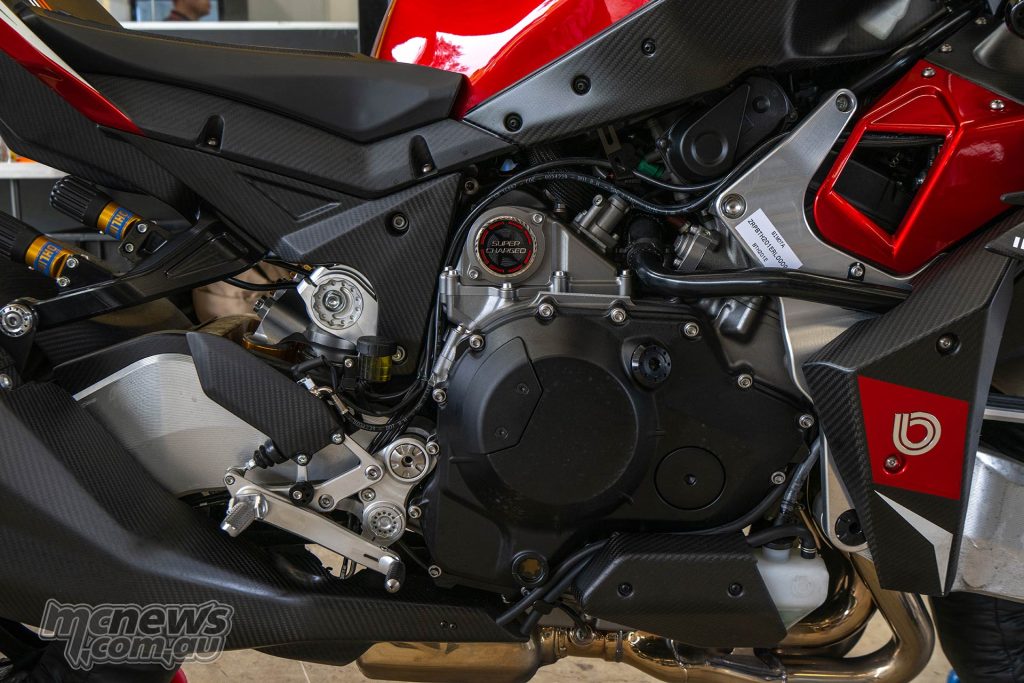
The Tesi H2 is a hugely powerful technological oddity that is quite bespoke, but one that is still pleasant to ride.
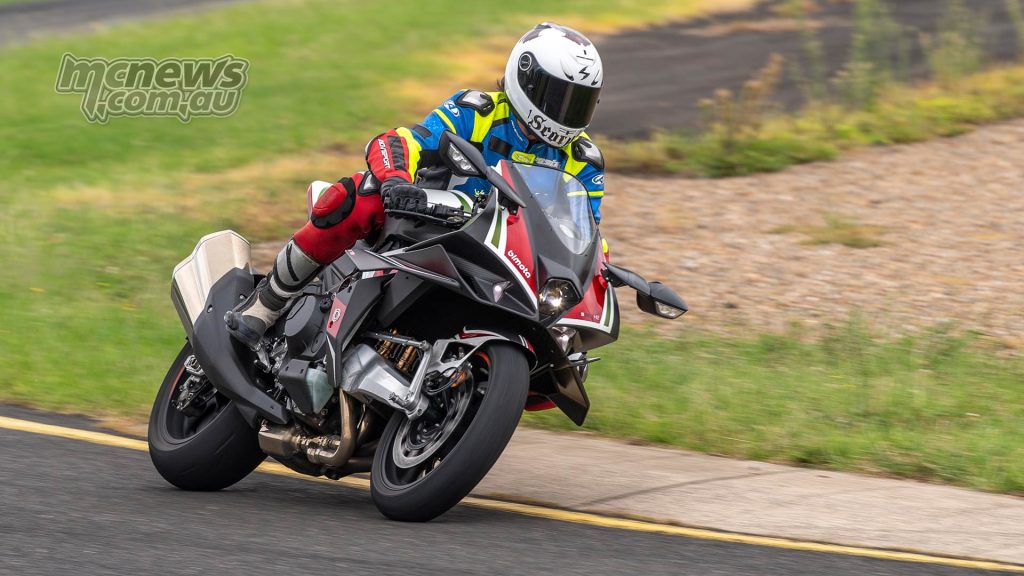
However, for me, the KB4 ticked more boxes. It just felt nicer to ride on its more conventional Ohlins suspension and the engine was more natural in its response.

I also preferred the much less powerful engine for road use. I’d pocket the $30K change and take that one home I reckon.
Bimota Tesi H2 Specifications
| Bimota Tesi H2 Specifications | |
| Engine | Four-stroke, four-cylinder, DOHC, four-valve, liquid-cooled, supercharged |
| Displacement | 998cc / 60,9 cu-in |
| Bore x Stroke | 76 x 55 mm |
| Compression Ratio | 8.5:1 |
| Power | 170 kW (231 hp) @ 11500 rpm |
| Torque | 141.7 Nm (104.51 lb-ft) @ 11,000 rpm |
| Fuel System | DFI with 50mm throttle bodies (4) with dual injection, Euro-4 |
| Ignition | TCBI with digital advance |
| Ignition Timing | 10° BTDC @ 1.100 rpm > 33° BTDC @ 11,000 rpm |
| Starting System | Electric starter |
| Cylinder Numbering Method | Left to right 1-2-3-4 |
| Firing Order | 1-2-4-3 |
| Lubrication System | Forced lubrication (wet sump) |
| Engine Oil Capacity | 5.0 L |
| Coolant Capacity | 2.5 L |
| Transmission | Six-speed, return shift, dog-ring, constant mesh |
| Clutch | Wet, multi disc |
| Final Drive | Sealed chain drive |
| Primary Reduction Ratio | 1.551 (76/49) |
| Final Reduction Ratio | 2.444 (44/18) |
| Overall Drive Ratio | 5.110 (Top gear) |
| Gear Ratios | 1st 3.188 (51/16), 2nd 2.526 (48/19), 3rd 2.045 ((45/22), 4th 1.727 (38/22), 5th 1.524 (32/21), 6th 1.348 (31/23) |
| Frame Type | Aluminum alloy plates billet machined, with rear swingarm mounting plate |
| Front Suspension | Öhlins TTX 36 nitrogen gas charged shock with piggyback reservoir, 24-way compression and rebound damping and adjustability and hand-turn spring preload adjustability, and top-out spring, 100 mm travel |
| Rear Suspension | Öhlins TTX36 nitrogen gas charged shock with piggyback reservoir, 24-way compression and rebound damping and adjustability and hand-turn spring preload adjustability, and top-out spring, 130 mm travel |
| Front Brakes | Dual radial-mount, opposed four-piston Brembo Stylema calipers, dual semi-floating 330 mm discs, KIBS ABS, opposed 2-piston calipers, single 220 mm disc, KIBS ABS |
| Tyres | 120/70 ZR17, 200/55 ZR17 |
| Rake/Trail | 21.3° / 117 mm |
| Overall Length | 2.074 mm |
| Overall Width | 770 mm |
| Overall Height | 1155 mm (+/-10 mm) |
| Ground Clearance | 140 mm (+/-10 mm) |
| Wheelbase | 1445 mm |
| Seat Height | 840 mm (+/-10 mm) |
| Curb Weight | 219 kg (1/3 tank fuel) |
| Fuel Capacity | 17 lt |
| Electronic Rider Aids | Kawasaki Cornering Management Function (KCMF), Kawasaki Traction Control (KTRC), Kawasaki Launch, Control Mode (KLCM), Kawasaki Intelligent anti-lock Brake System (KIBS), Kawasaki Engine Brake Control, Kawasaki Quick Shifter (KQS) (upshift & downshift), Öhlins Electronic Steering Damper, LED Cornering Lights |
Bimota KB4 Specifications
| Bimota KB4 Specifications | |
| Engine | Four-stroke, Four-cyl, DOHC, W/C |
| Valve system | 4-valve |
| Displacement | 1.043 cc |
| Bore x Stroke | 77 × 56 mm |
| Compression ratio | 11.8:1 |
| Max. power | 105 kW (142 HP) @ 10,000 rpm |
| Max. torque | 111 Nm (11.3 kgfm) @8,000 rpm |
| Lubrication system | Forced Lubrication (wet sump) |
| Engine oil capacity | 4.0 L |
| Fuel system | DFI 38 mm throttle bodies(4), Euro-5 |
| Transmission | Six-speed |
| Clutch type | Wet, multi-disc |
| Gear ratio | 1st 2.600(39/15); 2nd 1.950(39/20); 3rd 1.600(24/15); 4th 1.389(25/18); 5th 1.238(26/21); 6th 1.107(31/28) |
| Primary reduction ratio | 1.627 (83/51) |
| Final reduction ratio | 2.733(41/15) |
| Gasoline type | Unleaded premium |
| Fuel capacity | 19.5 L |
| Frame type | Front frame trellis made by Hi-resistance steel with Aluminum alloy plates |
| Overall length | 2050 mm |
| Overall Width | 774 mm |
| Overall Height | 1150 mm |
| Wheelbase | 1390 mm |
| Ground clearance | 140 mm |
| Seat height | 810 mm (+/- 8 mm) |
| Rake angle/Trail | 24.0°/ 100.8 mm |
| Front Suspension | Öhlins front fork FG R&T 43 NIX30, 130 mm travel |
| Rear Suspension | Aluminum alloy Swingarm billet with Öhlins TTX 36, 122mm travel |
| Tyre sizes | 120/70ZR17, 190/50ZR17 (F/R) |
| Wheels | Oz Racing Forged J17 M/C MT 3.50, MT6.00 (F/R) |
| Brakes | Dual disc 320 mm, Brembo monoblock calipers, single rear disc 220 mm |
| Curb weight | 194 kg |
























































































